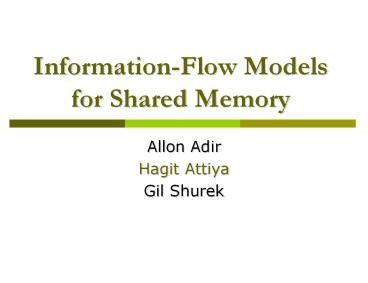Information-Flow Models for Shared Memory - PowerPoint PPT Presentation
1 / 26
Title:
Information-Flow Models for Shared Memory
Description:
Title: PowerPoint Presentation Last modified by: hagita Document presentation format: Custom Other titles: Times New Roman Garamond Arial Verdana Wingdings Times New ... – PowerPoint PPT presentation
Number of Views:66
Avg rating:3.0/5.0
Title: Information-Flow Models for Shared Memory
1
Information-Flow Models for Shared Memory
- Allon Adir
- Hagit Attiya
- Gil Shurek
2
Program Example
Initial state All0
Prog1
Prog2
load(X, R1)
load(Y, R3)
R2 R1
R3 R3 1
R1 1
store(R1, Y)
store(R3, X)
Final state R22 ?
3
Program Example
Initial state All0
Prog1
Prog2
load(X, R1)
load(Y, R3)
R2 R1
R3 R3 1
R1 1
store(R1, Y)
store(R3, X)
Final state YR11, XR2R32
4
PowerPC Consistency
Initial state All0
Prog1
Prog2
load(X, R1)
load(Y, R3)
R2 R1
R3 R3 1
R1 1
store(R1, Y)
store(R3, X)
Final state YR11, XR2R32
5
Shared-Memory Semantics
- Capturing intricate shared-memory behaviors
- Speculation
- Out-of-Order Execution
- Synchronization
- Granularity of Memory Accesses
- Without revealing micro-architecture details
6
Outline
- What is an Architecture?
- What is a Computation Model?
- The Framework
- Sequential Consistency
- PowerPC Consistency
7
What is an "Architecture"?
8
Elements of an Architecture
- Resources
- Granules
- States
- Instructions
- Formats
- Operands
- Source/Target
- Addressing-Mode
- State Transformation
9
Elements of an Architecture
- Program order
10
Computation Model
- Can we reach final state s2 by running a program
Prog from initial state s1? - Written as
- Is ás1, s2, Progñ possible?
11
Example Sequential Consistency
Initial state R1R2X0
Prog1 Prog2 store(R2, X) R11
R22 store(R1, X) store(R2, X)
Final state R11, R22, X0
X1 X2
12
The Framework
- Instruction instances Text order
- Flow-of-Information
Text Order
branch
store
cmp
nand
store
mul
load
load
xor
Is the flow-of-information allowed by the model?
13
The Elements
- Resource X,R
- Assignment resource-value pair (X,5)
- Operation in-out pair
((X,5),(R,5)) - Instruction ((X,0),(R,0)),
((X,1),(R,1)), ... - Program sequence of commands C1,...,Cm
- Command an instruction B and a function
- next B 1..mÈ
14
Program Order Example
Prog Instantiating Prog
C1 load(X,R1) C2 R3 R1R2 next(C1)2 next(C2
)
op1 ((X,1),(R1,1)) op2 ((R1,1),(R2,1),
(R3,2)) s1 (X,1), (R1,1), (R2,1),
(R3,1) s2 (X,1), (R1,1), (R2,1), (R3,2)
Program order s1 op1 op2 s2
15
Reads-From Mapping f
R2
s1 All1 load(X,R1) R3 R1R2 s2 R32,
others1
R1
16
Reads-From Mapping f
R2, X
R2
s1 All1 load(X,R1) R3 R1R2 s2 R32,
others1
R1
R1
R3
17
The Reads-From Mapping is not Cyclic
18
View orders lt
- Order the operations in Prog
- One for each Progi
- Obey architecture-specific rules relating
- program-order
- reads-from mapping
19
Sequential Execution
Information can not be read from the hidden past
I(X)
f(x)
op5
O(X)
lt
lt
lt
lt
op2
s2
op1
s1
op4
op3
20
Sequential Execution
Information can not be read from the future
f
op5
lt
lt
lt
lt
op2
s2
op1
s1
op4
op3
Relative to which order?
21
Sequential Consistency
- áS1,S2,Progñ is sequentially consistent if
- Prog can be instantiated with a set of
operations A and program order - A single view order
- linear
- extends the program order
- Information flow satisfies the sequential
- execution conditions relative to view order
22
PowerPC Consistency
- Information flow satisfies the sequential
execution conditions - Relative to program order
- Relative to view orders
23
PowerPC Consistency View Orders
- View orders enforce that
- Memory is coherent, except for local stores.
- Shared resource dependencies are preserved.
- sync orders operations around it.
- sync is transitive (sort of).
- Branch dependencies are preserved.
24
PowerPC Consistency View Orders I
25
PowerPC Consistency View Orders II
26
Speculation is Visible to Programs
Final state XY1 R11,R20 R31,R40





![[Latest Update] Microsoft DP-600 Actual Exam Practice Questions Shared Online PowerPoint PPT Presentation](https://s3.amazonaws.com/images.powershow.com/10142377.th0.jpg?_=20240928038)

























